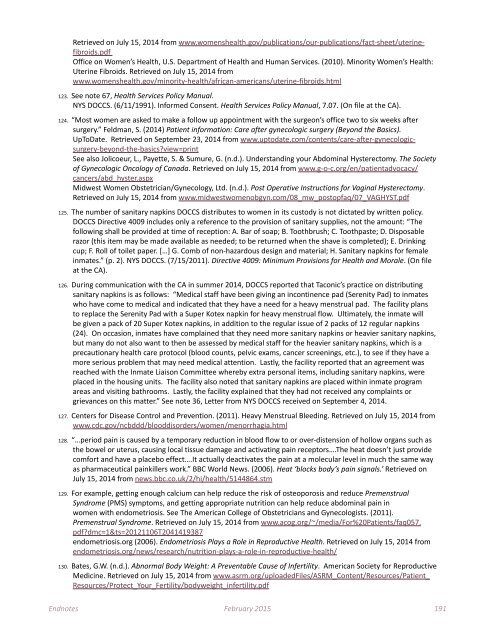Reproductive-Injustice-FULL-REPORT-FINAL-2-11-15
Reproductive-Injustice-FULL-REPORT-FINAL-2-11-15
Reproductive-Injustice-FULL-REPORT-FINAL-2-11-15
Create successful ePaper yourself
Turn your PDF publications into a flip-book with our unique Google optimized e-Paper software.
Retrieved on July <strong>15</strong>, 2014 from www.womenshealth.gov/publications/our-publications/fact-sheet/uterinefibroids.pdf<br />
Office on Women’s Health, U.S. Department of Health and Human Services. (2010). Minority Women’s Health:<br />
Uterine Fibroids. Retrieved on July <strong>15</strong>, 2014 from<br />
www.womenshealth.gov/minority-health/african-americans/uterine-fibroids.html<br />
123. See note 67, Health Services Policy Manual.<br />
NYS DOCCS. (6/<strong>11</strong>/1991). Informed Consent. Health Services Policy Manual, 7.07. (On file at the CA).<br />
124. “Most women are asked to make a follow up appointment with the surgeon’s office two to six weeks after<br />
surgery.” Feldman, S. (2014) Patient information: Care after gynecologic surgery (Beyond the Basics).<br />
UpToDate. Retrieved on September 23, 2014 from www.uptodate.com/contents/care-after-gynecologicsurgery-beyond-the-basicsview=print<br />
See also Jolicoeur, L., Payette, S. & Sumure, G. (n.d.). Understanding your Abdominal Hysterectomy. The Society<br />
of Gynecologic Oncology of Canada. Retrieved on July <strong>15</strong>, 2014 from www.g-o-c.org/en/patientadvocacy/<br />
cancers/abd_hyster.aspx<br />
Midwest Women Obstetrician/Gynecology, Ltd. (n.d.). Post Operative Instructions for Vaginal Hysterectomy.<br />
Retrieved on July <strong>15</strong>, 2014 from www.midwestwomenobgyn.com/08_mw_postopfaq/07_VAGHYST.pdf<br />
125. The number of sanitary napkins DOCCS distributes to women in its custody is not dictated by written policy.<br />
DOCCS Directive 4009 includes only a reference to the provision of sanitary supplies, not the amount: “The<br />
following shall be provided at time of reception: A. Bar of soap; B. Toothbrush; C. Toothpaste; D. Disposable<br />
razor (this item may be made available as needed; to be returned when the shave is completed); E. Drinking<br />
cup; F. Roll of toilet paper. […] G. Comb of non-hazardous design and material; H. Sanitary napkins for female<br />
inmates.” (p. 2). NYS DOCCS. (7/<strong>15</strong>/20<strong>11</strong>). Directive 4009: Minimum Provisions for Health and Morale. (On file<br />
at the CA).<br />
126. During communication with the CA in summer 2014, DOCCS reported that Taconic’s practice on distributing<br />
sanitary napkins is as follows: “Medical staff have been giving an incontinence pad (Serenity Pad) to inmates<br />
who have come to medical and indicated that they have a need for a heavy menstrual pad. The facility plans<br />
to replace the Serenity Pad with a Super Kotex napkin for heavy menstrual flow. Ultimately, the inmate will<br />
be given a pack of 20 Super Kotex napkins, in addition to the regular issue of 2 packs of 12 regular napkins<br />
(24). On occasion, inmates have complained that they need more sanitary napkins or heavier sanitary napkins,<br />
but many do not also want to then be assessed by medical staff for the heavier sanitary napkins, which is a<br />
precautionary health care protocol (blood counts, pelvic exams, cancer screenings, etc.), to see if they have a<br />
more serious problem that may need medical attention. Lastly, the facility reported that an agreement was<br />
reached with the Inmate Liaison Committee whereby extra personal items, including sanitary napkins, were<br />
placed in the housing units. The facility also noted that sanitary napkins are placed within inmate program<br />
areas and visiting bathrooms. Lastly, the facility explained that they had not received any complaints or<br />
grievances on this matter.” See note 36, Letter from NYS DOCCS received on September 4, 2014.<br />
127. Centers for Disease Control and Prevention. (20<strong>11</strong>). Heavy Menstrual Bleeding. Retrieved on July <strong>15</strong>, 2014 from<br />
www.cdc.gov/ncbddd/blooddisorders/women/menorrhagia.html<br />
128. “…period pain is caused by a temporary reduction in blood flow to or over-distension of hollow organs such as<br />
the bowel or uterus, causing local tissue damage and activating pain receptors….The heat doesn’t just provide<br />
comfort and have a placebo effect….It actually deactivates the pain at a molecular level in much the same way<br />
as pharmaceutical painkillers work.” BBC World News. (2006). Heat ‘blocks body’s pain signals.’ Retrieved on<br />
July <strong>15</strong>, 2014 from news.bbc.co.uk/2/hi/health/5144864.stm<br />
129. For example, getting enough calcium can help reduce the risk of osteoporosis and reduce Premenstrual<br />
Syndrome (PMS) symptoms, and getting appropriate nutrition can help reduce abdominal pain in<br />
women with endometriosis. See The American College of Obstetricians and Gynecologists. (20<strong>11</strong>).<br />
Premenstrual Syndrome. Retrieved on July <strong>15</strong>, 2014 from www.acog.org/~/media/For%20Patients/faq057.<br />
pdfdmc=1&ts=2012<strong>11</strong>06T2041419387<br />
endometriosis.org (2006). Endometriosis Plays a Role in <strong>Reproductive</strong> Health. Retrieved on July <strong>15</strong>, 2014 from<br />
endometriosis.org/news/research/nutrition-plays-a-role-in-reproductive-health/<br />
130. Bates, G.W. (n.d.). Abnormal Body Weight: A Preventable Cause of Infertility. American Society for <strong>Reproductive</strong><br />
Medicine. Retrieved on July <strong>15</strong>, 2014 from www.asrm.org/uploadedFiles/ASRM_Content/Resources/Patient_<br />
Resources/Protect_Your_Fertility/bodyweight_infertility.pdf<br />
Endnotes February 20<strong>15</strong> 191


